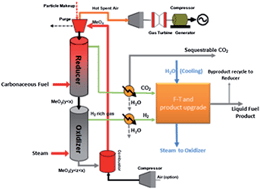Chemical looping processes for CO2 capture and carbonaceous fuel conversion – prospect and opportunity
Abstract
Chemical looping processes offer a compelling way for effective and viable carbonaceous fuel conversion into clean energy carriers. The uniqueness of chemical looping processes includes their capability of low cost in situ carbon capture, high efficiency energy conversion scheme, and advanced compatibility with state-of-the-art technologies. Based on the different functions of looping particles, two types of chemical looping technologies and associated processes have been developed. Type I chemical looping systems utilize oxygen carrier particles to perform the reduction–oxidation cycles, while Type II chemical looping systems utilize CO2 carrier particles to conduct carbonation–calcination cycles. The exergy analysis indicates that the chemical looping strategy has the potential to improve fossil fuel conversion schemes. Chemical looping particle performance and looping reactor engineering are the key drivers to the success of chemical looping process development. In this work, the desired particle characterization and recent progress in mechanism studies are generalized, which is followed by a discussion on the looping reactor design. This perspective also illustrates various chemical looping processes for combustion and gasification applications. It shows that both Type I and Type II looping processes have great potentials for flexible and efficient production of electricity, hydrogen and liquid fuels.

- This article is part of the themed collection: Carbon Dioxide

 Please wait while we load your content...
Please wait while we load your content...